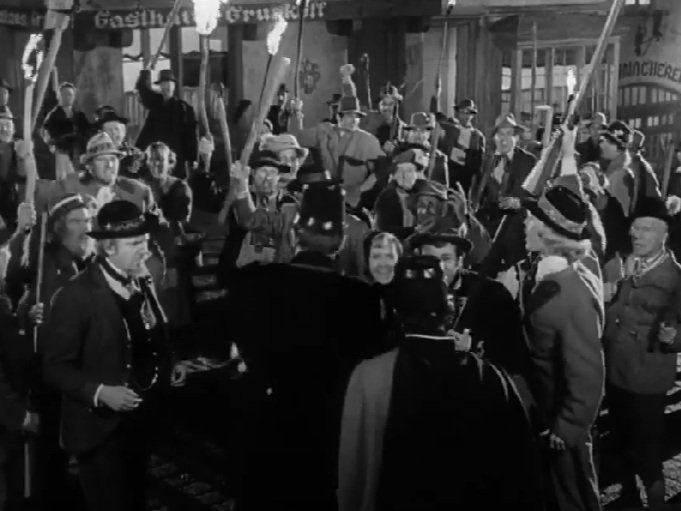Mel Brooks, dir., Young Frankenstein (United States: Twentieth Century Fox, 1974), https://www.youtube.com/watch?v=9yL89sTITZQ.
“I understand the importance of history,” a local city council member remarked to us recently, “but we cannot prioritize the dead over the living.”
This is not an uncommon sentiment.
Nor is it completely wrong.
Every building needs to be useful to the living for its owner to be incentivized to maintain it and thereby preserve it. In this way, preservationists have the same goal as property owners. The role of preservationists, then, is to demonstrate how a building built for a different time, even one that many consider an eyesore, can be profitably adapted to the needs of people today.
For decades, preservationists fought hard to protect their unique local stories. These preservationists were vocal and determined, often compared to an angry mob with pitchforks protecting their communities from greedy heartless villains. Their efforts saved countless places across the country and persuaded the passage of federal, state, and local laws to better protect places in the future.
But recently, perceptions have shifted. Some preservationists are viewed as having no apparent financial stake in the outcome yet wielding their pitchforks to force property owners into unnecessary and burdensome financial obligations. Preservation seems to be a fight over who is right rather than what would be best for the community, and the public has lost interest.
In short, preservation lost relevancy.
Historic structures and landscapes are not seen as relevant to people’s lives anymore according to a 2023 report from Landmarks Illinois, the state’s leading voice on historic preservation.
Because of this “relevancy crisis,” Landmarks Illinois found that “the field faces fundamental challenges: embattled regulatory tools, a lack of political and public support (or downright hostility), misinformation and insufficient funding.”[1]
If historic preservation was to regain its significance, preservation needed to regain its relevancy. The public needed to see how preservation applied to their lives.
What was relevant to people, Landmarks Illinois found, were solutions.
“A relevant tool,” Landmarks Illinois wrote in its report, “solves a problem that connects, relates, and is applicable to a person’s life.”[2] People do not want pitchforks anymore. They want solutions.
Several years ago, the Board of Directors of Preservation Partners, like Landmarks Illinois, recognized that confrontation with those opposed to preservation had lost effectiveness. They re-aligned our approach, seeking collaboration with all stakeholders as PARTNERS, just as our name suggests.
Our focus now is on solutions. A recent example proves how this approach is successful.
1904 Heinz Brothers Cut Glass Factory, St. Charles
In 2022, the owner of a brick factory built in 1904 on the east side of St. Charles decided to demolish the structure. The owner had planned to turn the factory into condos but changes in their financial situation caused them to scrap their plan. Left abandoned, the building quickly deteriorated and became a terrible eyesore for the neighborhood. The public demanded action and many supported the building’s demolition.
When we learned of the pending demolition, we contacted a local developer, explained the situation, and suggested that they purchase and rehabilitate the building. After months of negotiation, this developer purchased it and late last year opened it as an apartment building. The public reaction was outstanding!
The public supported demolition and then rehabilitation. In other words, the public supported A SOLUTION. They cared less about the specific solution and more about any solution at all.
This demonstrates how preservationists can be effective today. Clearly, preservationists want to preserve historic structures and will be biased in that direction. However, to be successful, preservation must solve a problem.
Regardless of its historic significance, a building that does not have a purpose does not benefit anyone. Without benefit, the public cannot recognize a building’s relevance and will therefore not support its preservation. By focusing on solutions, preservationists demonstrate reasonableness and appreciation for challenges faced in the present.
How we partner...
Federal, state, and local laws, hard fought for by preservationists, give us tools to evaluate each situation as objectively as possible. We express our perspective rather than advocate for a specific outcome and when a building meets the criteria for demolition we do not hesitate to say so. Rather than cast a property owner as a villain, we reach out to educate them on the benefits of historic preservation, expert contractors if needed, financial incentives that may be available, and possibilities for adaptive reuse. We also consult local preservationists, city staff, and city council members.
The goal is to be a partner in developing a solution that benefits the property owner and strengthens the community.
Developers, city staff, and city council members have positively commented on our approach.
…and how we need you!
Change from what has worked in the past is often difficult to do. The impulse to pick up a pitchfork is tempting! Yet, partnering with stakeholders such as the property owner, the city, and the public is more effective. Solutions are relevant. A solution mindset rallies support.
Will you, too, put the pitchforks away and become a partner?
Visit ppfv.org/membership to join us today!
Thank you for reading! If this story interested, inspired, or informed you, please consider subscribing to our monthly e-newsletter so more of these stories come right to you!
[1] Bonnie C. McDonald, The Relevancy Guidebook: How We Can Transform the Future of Preservation, ed. Jean A. Follett (Chicago: Landmarks Illinois, 2023), 10, https://www.landmarks.org/relevancy-guidebook/TheRelevancyGuidebook.pdf.
[2] Ibid.


